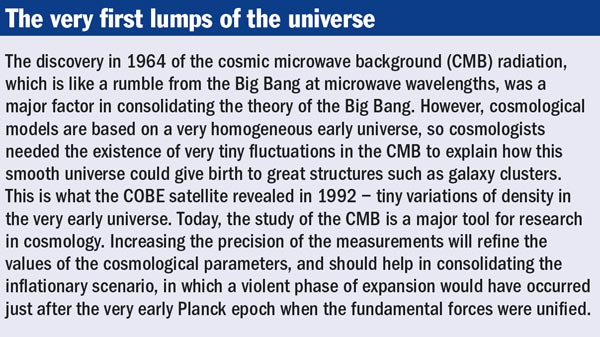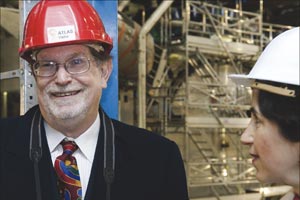During a visit to CERN, 2006 Nobel laureate George Smoot talked to Arnaud Marsollier about his quest to explore the early universe, and how cosmology and particle physics are coming together in a grand crusade.

George Smoot feels at home when he is at CERN: as he walks through the corridors he always meets colleagues waving to him. This is not surprising as he has often visited the laboratory during the past 20 years. And even if he is now considered one of the great cosmologists, he remembers that his work began in particle physics when he was a PhD student.
As Smoot himself says, he was destined to be a scientist: he is cut out to do it. He remembers that as a child he asked his parents how the Moon could appear to follow their car and at the same time all the cars in the world. When they explained about the Earth and the Moon, it was a revelation for him and perhaps the beginning of his career. So, while still very young, Smoot read about Galileo, who became his hero. Was he not one of the first experimental physicists and the first astronomer to turn a telescope to the sky?

Later, Smoot joined the Massachusetts Institute of Technology where he thought first of studying medicine. But physics and mathematics finally called him and he majored in these subjects in 1966 before focusing on particle physics, in which he obtained his doctorate in 1970. Soon he switched to cosmology, moving to the Lawrence Berkeley National Laboratory (LBNL) where he has worked and taught for more than three decades.
From the rainforests of Brazil to the bleak plains of Antarctica, Smoot has covered the whole world looking for what he likes to call “the holy grail of cosmology” – evidence for the Big Bang. This Indiana Jones of cosmology also likes playing with the big toys of technology and has used all he can to penetrate the mysteries of the early universe: high-altitude experimental balloons, U2 spy planes, satellites and so on. At LBNL he began work on the High-Altitude Particle Physics Experiment (HAPPE), aiming to find antimatter in the upper atmosphere, and cast light on the theory of the Big Bang. While he did not find antimatter with HAPPE, he did go on to discover the long-sought hard evidence for the Big Bang. In 1974 he had begun work on a proposal to map the cosmic microwave background (CMB) radiation. This later blossomed into NASA’s Cosmic Background Explorer (COBE), with which he discovered small fluctuations in the CMB in 1992.

In 2006 Smoot won the Nobel Prize in Physics for this major milestone in our knowledge about the origin of the universe (see box 1). It is as if he had taken a photograph of the baby universe, succeeding where others had failed for so long. To achieve this breakthrough, he invented precision cosmology, managing to measure very tiny differences in the temperature of the cosmological background radiation at the level of a hundred-thousandth of a degree. His discovery is really a revolution, perhaps the greatest since the confirmation of the theory of general relativity. What Smoot calls the “wrinkles in time” gives us a new view of the very early universe, prefiguring the formation of large structures such as galaxies. And what is most exciting for him, is that in his opinion we now have one clear picture for the origin of the universe, which transcends cultures, religions and other differences the world over.
The discovery was by no means easy. Smoot and his team had to analyse and clean a large amount of data, verifying them again and again before being sure of the results. (This is more or less what physicists at CERN will have to do soon with the experiments at the LHC.) At the end of this meticulous work, however, he felt so confident about his results that he said he would offer a plane ticket to any destination to anyone who could find a mistake.
Smoot has now been tracking fluctuations in cosmological background radiation for more than 30 years, but he is not yet ready to step down. Now he is working on the Planck mission, the European successor to the Wilkinson Microwave Anisotropy Probe, which will give a higher precision than ever before. It is due to launch in 2008, when the LHC will be collecting its first data. “In the following three or four years, the most exciting physics experiments will be Planck and the LHC,” says Smoot. He is expecting much from the LHC experiments, so it is no coincidence that he went to see ATLAS and CMS during his visit to CERN. He says that “CERN is the place to be,” adding that if he was a PhD student now he would want to work there.

With Planck, Smoot hopes to answer new questions about the shape of the universe and the inflationary model, so he thinks it would be very exciting to find something unusual at the LHC, such as extra dimensions or supersymmetry – something really revolutionary that would be exciting for the next generation. Whatever is found, it will open new windows on the universe and give new lines of research for physics. For Smoot, even though they have followed different paths, cosmology and particle physics are now asking the same questions – they are merging. He explained in the talk he gave at CERN how cosmological data could be used to test fundamental-physics models, providing frameworks and constraints. “We are living in the golden age of cosmology,” he says. Now he is waiting for the next cliffhanger in our exploration of the universe and is certain to be one of the main players in this next scientific crusade.
Further reading
G Smoot and K Davidson 1994 Wrinkles in time (Avon Books).





